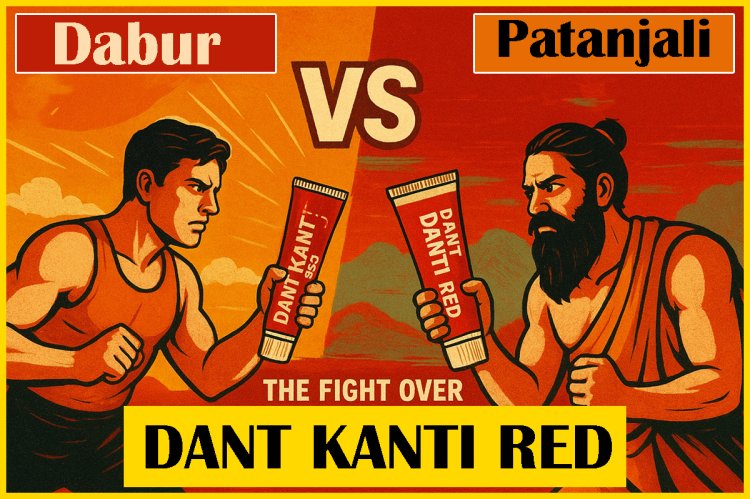"Packaging at War: Dabur vs Patanjali and the Fight Over ‘Dant Kanti Red’"
Dabur India has filed a lawsuit against Patanjali Ayurved over the packaging of its “Dant Kanti Red” toothpaste, alleging trade dress infringement and consumer confusion. Mediation failed, and the dispute is now before the Delhi High Court, with hearings scheduled for October 6 and December 5, 2025.

INTRODUCTION
In the trade dress issue regarding the packaging of "Dant Kanti Red" toothpaste, Dabur India Ltd. and Patanjali Ayurved Ltd. were unable to resolve the dispute through mediation. The dispute is being pursued at the Delhi High Court due to the mediation's failure. Dabur alleges that Patanjali’s packaging for its pan-flavored Dant Kanti Red, adopted in December 2024, bears a striking resemblance to its flagship Dabur Red toothpaste, potentially misleading consumers and constituting trade dress infringement and passing off. Justice Manmeet Pritam Singh Arora confirmed on August 1, 2025 that mediation has been attempted and failed, and launched the formal legal timeline. The case is now set for further proceedings, with a joint registrar hearing on October 6, 2025 and a substantive court hearing scheduled for December 5, 2025. There will now be a joint registrar hearing on October 6, 2025, and a substantive court hearing on December 5, 2025, in order to continue the case.
The battle over toothpaste packaging between Dabur India Ltd. and Patanjali Ayurved Ltd. has moved from the mediation table to the courtroom. After talks failed to resolve Dabur’s claim that Patanjali’s pan-flavored “Dant Kanti Red,” launched in December 2024, copies the look of its flagship Dabur Red toothpaste, the dispute is now before the Delhi High Court. Dabur argues the packaging’s similarities could mislead consumers and amount to trade dress infringement and passing off. On August 1, 2025, Justice Manmeet Pritam Singh Arora confirmed mediation had failed and set the legal process in motion, with a joint registrar hearing scheduled for October 6 and a substantive hearing on December 5.
BACKGROUND AND TIMELINE
This case represents a classic intellectual property dispute between two major players in the fast-moving consumer goods (FMCG) market in India. The core issue is not a direct trademark conflict over a single word, but rather a claim of "trade dress" infringement, which relates to the overall visual appearance and packaging of a product.
CORE OF THE DISPUTE
While the companies have co-existed in the market for some time, the legal battle escalated after Patanjali introduced a new packaging design for its "Dant Kanti Red (Pan Flavour)" toothpaste in December 2024.
THE SUBJECT OF THE DISPUTE: "Trade Dress" Infringement
Dabur's Position: Dabur India has a long-standing and highly recognizable product, "Dabur Red" toothpaste. The company claims to have established a unique and distinctive "trade dress" for this product over many years. This includes a specific combination of colors, fonts, layout, and visual elements on the toothpaste tube and packaging.
Patanjali's New Packaging: In December 2024, Patanjali launched a new packaging design for its "Dant Kanti Red (Pan Flavour)" toothpaste. Dabur alleges that this new design is "deceptively similar" to the trade dress of its "Dabur Red" product.
Key Allegation: Dabur has clarified that it is not challenging Patanjali's use of the word "Red" or the use of a "pan leaf" image, as these elements are common in the industry. The lawsuit is specifically focused on the overall look and feel of the new packaging, which Dabur argues is an attempt to imitate its brand identity and mislead consumers.
To know more about this you can follow the link below:
The Failed Mediation
Dabur's Allegation: Dabur filed a lawsuit in the Delhi High Court, arguing that Patanjali's new packaging for "Dant Kanti Red" is "deceptively similar" to its own "Dabur Red" toothpaste. Dabur's primary contention is not with the use of the word "Red" or the "pan leaf" symbol, but rather with the overall visual appearance, or "trade dress," of the new packaging. Dabur claims that this similarity is likely to confuse consumers and erode its brand identity.
Pre-Institution Mediation: Under Section 12A of the Commercial Courts Act, 2015, a plaintiff in a commercial dispute must first attempt to resolve the matter through a mandatory pre-institution mediation. The Delhi High Court referred the case to mediation, encouraging both parties to find an amicable solution. The court also reportedly suggested that Patanjali consider changing its packaging to avoid confusion.
Mediation Fails: The Delhi High Court was notified on August 1, 2025, that the mediation procedures had not resulted in a settlement. Despite their best efforts, neither party was able to negotiate a settlement, which they both reported to the court.
Legal Proceedings and Relief Sought:
In order to prevent Patanjali from utilising the allegedly infringing packaging, Dabur is requesting a permanent injunction. The court has directed timelines for filing written statements and replication affidavits, with further hearings scheduled through late 2025.
Related Litigation: Chyawanprash Ad Dispute
Patanjali is concurrently facing another legal tussle with Dabur over allegedly disparaging advertisements for Chyawanprash. Dabur has challenged certain ads, and Patanjali has defended them as mere “puffery”, asserting these ads do not reference Dabur directly or amount to unfair comparison.This case runs separately but highlights the broader pattern of legal friction between the two FMCG giants.
CONCLUSION
The Dabur vs. Patanjali dispute over the "Dant Kanti Red" packaging underscores the growing importance of trade dress protection in India’s competitive FMCG sector. While both companies have co-existed for years, the case highlights how visual identity and packaging can serve as powerful tools for brand differentiation—and equally as potential sources of legal conflict. With mediation having failed, the Delhi High Court will now examine whether Patanjali’s new packaging creates consumer confusion or amounts to unfair imitation. The outcome of this case will not only determine the immediate commercial stakes for Dabur and Patanjali but may also set important precedents for future trade dress disputes in India’s fast-moving consumer goods market.












